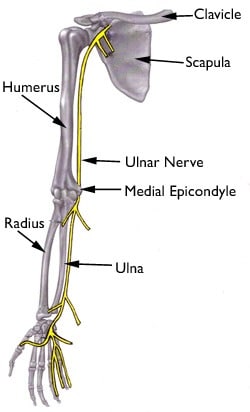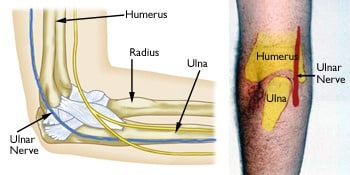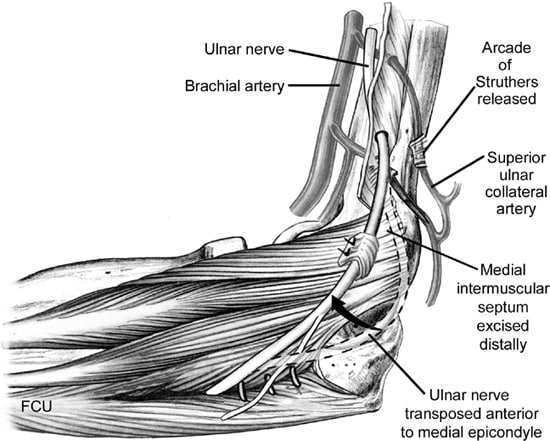Serving Wappingers Falls, Beacon, Lagrangeville, Brewster, Carmel & Nearby Areas Of Hudson Valley
Cubital Tunnel Syndrome
Ulnar nerve entrapment occurs when the ulnar nerve in the arm becomes compressed or irritated. The ulnar nerve is one of the three main nerves in your arm. It travels from your neck down into your hand, and can be constricted in several places along the way.
Depending upon where it occurs, this pressure on the nerve can cause numbness or pain in your elbow, hand, wrist, or fingers. If you want to know if you can make a personal injury claim based on an ulnar nerve injury or the development of cubital tunnel syndrome, please call the Maurer Law Firm at 845-896-5295 or schedule your free consultation using our online contact form here.
Sometimes the ulnar nerve gets compressed at the wrist, beneath the collarbone, or as it comes out of the spinal cord in the neck. The most common place where the nerve gets compressed is behind the elbow. When the nerve compression occurs at the elbow, it is called "cubital tunnel syndrome."
Anatomy of the Elbow
At the elbow, the ulnar nerve travels through a tunnel of tissue (the cubital tunnel) that runs under a bump of bone at the inside of your elbow. This bony bump is called the medial epicondyle. The spot where the nerve runs under the medial epicondyle is commonly referred to as the "funny bone." At the funny bone the nerve is close to your skin, and bumping it causes a shock-like feeling.
Beyond the elbow, the ulnar nerve travels under muscles on the inside of your forearm and into your hand on the side of the palm with the little finger. As the nerve enters the hand, it travels through another tunnel (Guyon's canal).
The ulnar nerve gives feeling to the little finger and half of the ring finger. It also controls most of the little muscles in the hand that help with fine movements, and some of the bigger muscles in the forearm that help you make a strong grip.

Risk Factors for Developing Cubital Tunnel Syndrome
Some factors put you more at risk for developing cubital tunnel syndrome. These include:
- Prior fracture or dislocations of the elbow
- Bone spurs/ arthritis of the elbow
- Swelling of the elbow joint
- Cysts near the elbow joint

- Repetitive or prolonged activities that require the elbow to be bent or flexed
- Repeatedly leaning on your elbow, especially on a hard surface
- Bending your elbow for sustained periods, such as while talking on a cell phone or sleeping with your hand crooked under your pillow
Check out our Personal Injury Blog for more information.
Cubital Tunnel Syndrome Symptoms
Cubital tunnel syndrome can cause an aching pain on the inside of the elbow. Most of the symptoms, however, occur in your hand.
Ulnar nerve entrapment can give symptoms of "falling asleep" in the ring finger and little finger, especially when your elbow is bent. In some cases, it may be harder to move your fingers in and out, or to manipulate objects.
Numbness and tingling in the ring finger and little finger are common symptoms of ulnar nerve entrapment. Often, these symptoms come and go. They happen more often when the elbow is bent, such as when driving or holding the phone. Some people wake up at night because their fingers are numb.
Weakening of the grip and difficulty with finger coordination (such as typing or playing an instrument) may occur. These symptoms are usually seen in more severe cases of nerve compression.
If the nerve is very compressed or has been compressed for a long time, muscle wasting in the hand can occur. Once this happens, muscle wasting cannot be reversed. For this reason, it is important to see your doctor if symptoms are severe or if they are less severe but have been present for more than 6 weeks.
Cubital Tunnel Syndrome Treatment
Unless your nerve compression has caused a lot of muscle wasting, your doctor will most likely first recommend nonsurgical treatment.
Nonsurgical Treatment
- Non-steroidal anti-inflammatory medicines. If your symptoms have just started, your doctor may recommend an anti-inflammatory medicine, such as ibuprofen, to help reduce swelling around the nerve.
- Steroid injections. Steroids, like cortisone, are very effective anti-inflammatory medicines. Injecting steroids around the ulnar nerve is generally not used because there is a risk of damage to the nerve.
- Bracing or splinting. Your doctor may prescribe a padded brace or split to wear at night to keep your elbow in a straight position.
- Nerve gliding exercises. Some doctors think that exercises to help the ulnar nerve slide through the cubital tunnel at the elbow and the Guyon's canal at the wrist can improve symptoms. These exercises may also help keep the arm and wrist from getting stiff.
Surgical Treatment
- Your doctor may recommend surgery to take pressure off of the nerve if:
- Nonsurgical methods have not improved your condition
- The ulnar nerve is very compressed
- Nerve compression has caused muscle wasting
There are a few surgical procedures that will relieve pressure on the ulnar nerve at the elbow. Your orthpaedic surgeon will talk with you about the option that would be best for you.
These procedures are most often done on an outpatient basis, but some patients do best with an overnight stay at the hospital.
Cubital tunnel release. In this operation, the ligament "roof" of the cubital tunnel is cut and divided. This increases the size of the tunnel and decreases pressure on the nerve. After the procedure, the ligament begins to heal and new tissue grows across the division. The new growth heals the ligament, and allows more space for the ulnar nerve to slide through. Cubital tunnel release tends to work best when the nerve compression is mild and the nerve does not slide out from behind the bony ridge of the medial epicondyle when the elbow is bent.

Ulnar nerve anterior transposition. More commonly, the nerve is moved from its place behind the medial epicondyle to a new place in front of it. This is called an anterior transposition of the ulnar nerve. The nerve can be moved to lie under the skin and fat but on top of the muscle (subcutaneous transposition), within the muscle (intermuscular transposition) or under the muscle (submuscular transposition). Moving the nerve to the front of the medial epicondyle prevents it from getting caught on the bony ridge and stretching when you bend your elbow.
Medial epicondylectomy. Another option to release the nerve is to remove part of the medial epicondyle. Like ulnar nerve transposition, this technique also prevents the nerve from getting caught on the boney ridge and stretching when your elbow is bent.
Surgical Recovery
Depending on the type of surgery you have, you may need to wear a splint for a few weeks after the operation. A submuscular transposition usually requires a longer time (3 to 6 weeks) in a splint. Your surgeon may recommend physical therapy exercises to help you regain strength and motion in your arm. He or she will also talk with you about when it will be safe to return to all your normal activities.
Surgical Outcome
The results of surgery are generally good. Each method of surgery has a similar success rate for routine cases of nerve compression. If the nerve is very badly compressed or if there is muscle wasting, the nerve may not be able to return to normal and some symptoms may remain even after the surgery. Nerves recover slowly, and it may take a long time to know how well the nerve will do after surgery.
Read our fantastic reviews: "Ira M. Maurer is a superb attorney..."
Schedule Your Consultation Today
If you or a loved one has suffered a repetitive stress injury, you may be entitled to compensation. Please contact The Maurer Law Firm by calling 845-896-5295 to schedule a free consultation with our experienced Fishkill lawyer Ira Maurer. Attorney Ira M. Maurer serves clients in surrounding areas including Dutchess County, Orange County and throughout the Hudson Valley.





